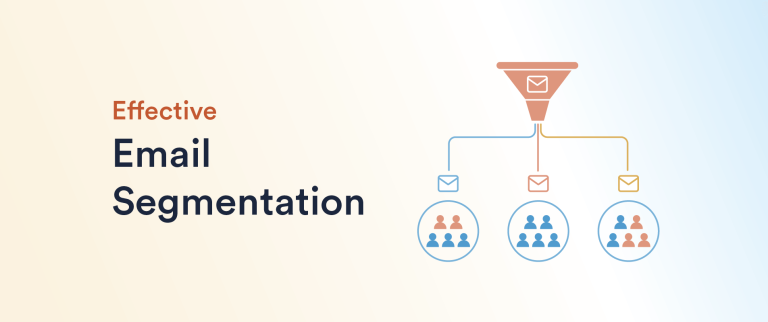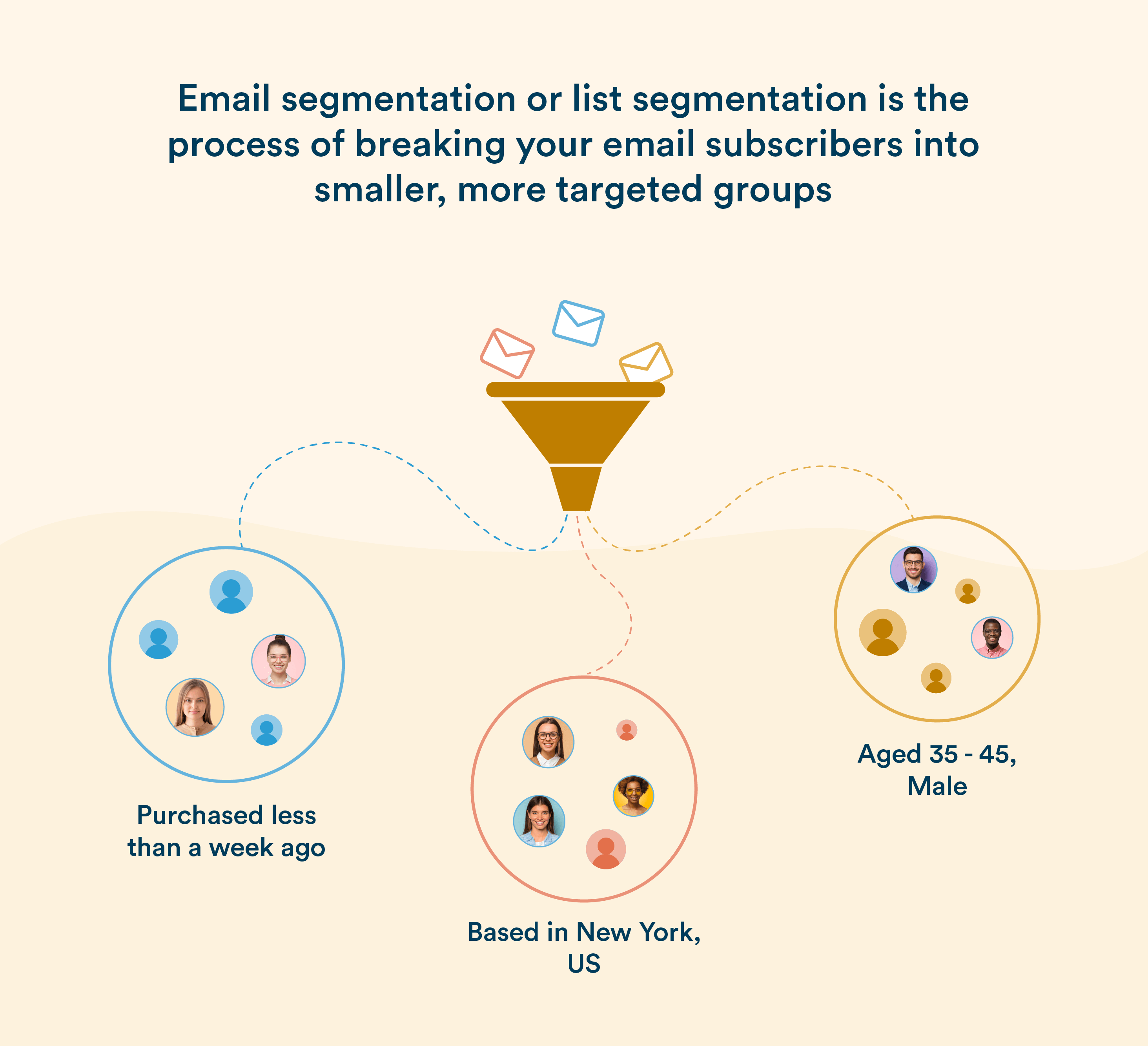Learn how you can Unlock Limitless Customer Lifetime Value with CleverTap’s All-in-One Customer Engagement Platform.

This article explores the power of email segmentation, a strategy that allows marketers to create more personalized and effective campaigns. By dividing email lists into smaller, targeted groups based on behavior and interests, businesses can drive higher engagement, conversions, and ROI.
It happens every day—your inbox floods with dozens of emails, most of which you delete without opening. Generic emails don’t make the cut anymore. And your audience feels the same way.
Yet, email remains one of the strongest marketing channels. With over 4.3 billion users worldwide and an ROI of $36 for every $1 spent, it’s clear email isn’t going anywhere. So, what sets successful campaigns apart from those that get ignored?
The answer: Relevance.
Imagine delivering value to each customer segment. Sending product recommendations based on past purchases or tailoring offers to your most loyal customers. This kind of personalization is what makes emails stand out—and what drives action.
The secret to achieving this? A simple but powerful tool called email segmentation.
In this article, you’ll learn:
Let’s dive into how segmenting email lists can make every message count.

Email segmentation or list segmentation is the process of breaking your email subscribers into smaller, more targeted groups. These segments can be based on various data points, such as demographics, behaviors, interests, purchase history, or geographic location.
The goal? To send each group personalized content that feels relevant and valuable to them. When done right, segmentation drastically improves engagement and opens the door to meaningful interactions with your audience.
Sending the same email to an entire list may feel easier, but it often leads to missed opportunities. Why? Because people aren’t all the same. A customer who just bought a product might want to see complementary recommendations, while someone who hasn’t engaged in months needs a nudge with a re-engagement campaign. List segmentation allows you to deliver a message that feels personal, no matter where the recipient is in their journey.
And it’s more than just a strategy—it’s a way to drive real results. Research from DMA shows that segmenting email campaigns can lead to a 760% increase in revenue. It’s not just about getting into the inbox; it’s about showing up with content that resonates. The smaller the segment, the more tailored your message should be, which ensures each email feels like it was crafted for the recipient.
Email segmentation strategy can start simple— dividing your list by age or location—but the most impactful ones go deeper. Advanced methods use behavioral data and predictive analytics, allowing brands to anticipate customer needs and send timely, relevant emails. With the right tools, you can automate these processes and deliver personalized experiences at scale, without sacrificing quality or impact.
Segmenting email lists isn’t just a marketing tactic—it’s a powerful tool that can elevate the success of your campaigns. In a crowded inbox, generic emails get lost. Here’s why email segmentation makes a world of difference:
Segmentation directly improves open and click-through rates. Targeted campaigns have 14.32% higher open rates than non-segmented ones, meaning more eyes on your emails and more engagement with your content.
When emails are tailored to subscriber preferences, the likelihood of action increases. Segmented campaigns can see up to a 760% boost in revenue, turning personalized messaging into a powerful driver of sales.
Irrelevant content often leads to higher unsubscribe rates. List segmentation ensures subscribers receive emails aligned with their interests, reducing churn and keeping your audience engaged.
Segmentation helps you build lasting connections. By sending the right message at the right time, you nurture customer loyalty. 80% of consumers are more likely to make purchases from brands that personalize their communication.
Precision targeting leads to better results with less effort. Every email sent to a specific segment has a higher chance of success, resulting in a significant increase in return on investment for your email marketing.
Email segmentation ensures each email resonates, driving higher engagement, conversions, and overall marketing success.
Email marketing segmentation offers endless possibilities, depending on the data available and the goals of your campaign. By using different segmentation methods, you can ensure that your audience receives content that is highly relevant to them. Here are some of the most effective ways to segment your email lists:
By utilizing these segmentation strategies, you can send more relevant emails that resonate with your audience, boosting engagement and conversions. Whether you’re using simple demographics or advanced predictive analytics, the key is to align your segments with your marketing goals and the specific needs of your subscribers.

Building a successful email list is about more than just collecting addresses. It’s about gathering the right data, setting up automated workflows, and continually improving your efforts. Here’s how to do it:
Before you start collecting data, it’s crucial to decide what criteria will define your email segments. This could include demographic information, behavioral data, geographic location, or customer preferences. By clearly identifying these criteria upfront, you’ll be able to create targeted and relevant email campaigns.
Once your criteria are in place, use forms, surveys, or purchase history to collect relevant data from your audience. Automate the process by setting up workflows in your email marketing platform. For instance, you can trigger specific emails based on user behavior, like welcome emails for new subscribers or re-engaging inactive ones.
With your data collected and workflows in place, it’s time to craft your emails. Make sure each segment receives tailored content that speaks to their specific needs or interests. Start sending your campaigns, ensuring your messages are relevant to the target segment.
After launching your email campaigns, closely monitor their performance. Track key metrics like open rates, click-through rates, and conversion rates for each segment. Plan A/B testing of different subject lines, offers, and content to see what resonates most with each group. Continuous testing and optimization are key to improving results over time.
To elevate your email marketing, leverage automation tools that integrate email with other key channels. This integration ensures your audience receives consistent, personalized communication across their entire journey.
Consider comprehensive solutions that simplify omnichannel automation, helping you create coordinated campaigns across multiple channels and engage with your customers with a deeper context.
Email segmentation is no longer a nice-to-have strategy; it’s an essential component of successful email marketing. By dividing your audience into targeted groups, you ensure that each subscriber receives personalized content that speaks to their specific interests and behaviors. This approach leads to higher engagement, improved conversion rates, and more efficient use of your marketing resources.
To recap, here are the key takeaways from this article:
Ready to optimize your email marketing with smarter segmentation? Discover how CleverTap can help you automate, personalize, and scale your email campaigns for better results. Explore CleverTap’s email solutions here.